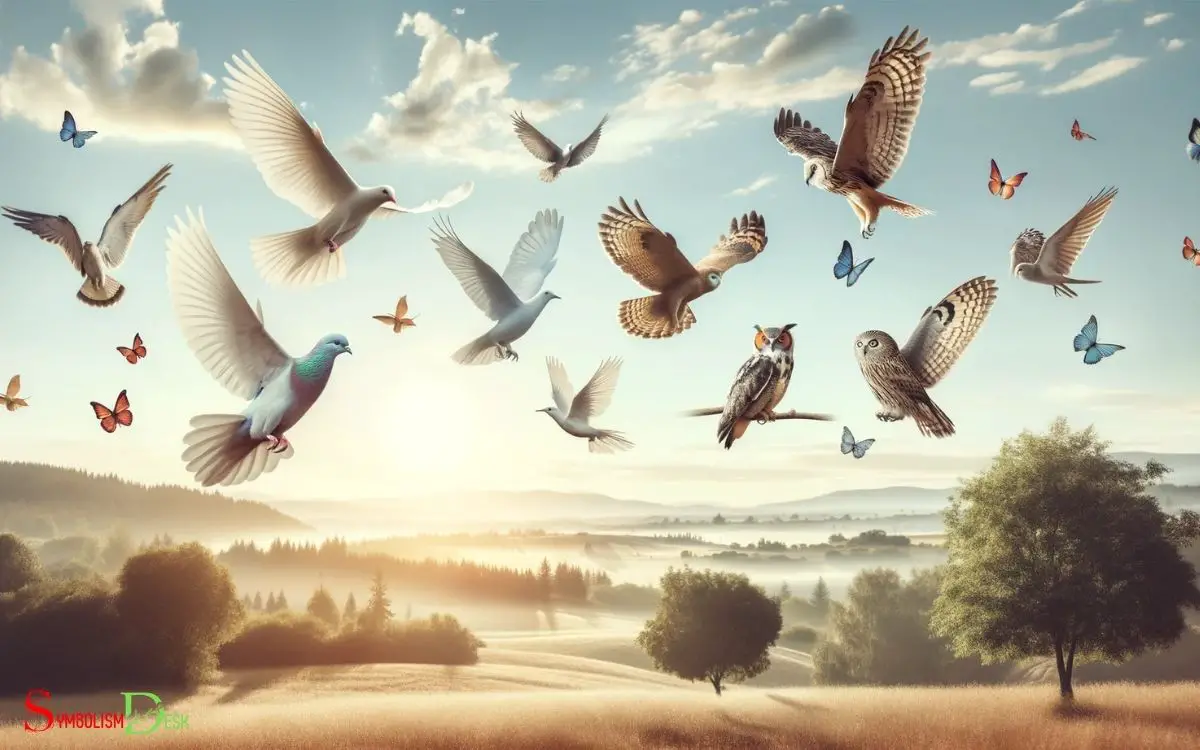Symbolic Meaning of Different Birds: Freedom!
The symbolic meanings of different birds vary widely, with each species carrying its own cultural and spiritual significance. For instance, eagles represent strength and freedom, while swans symbolize grace and love.
Birds, with their ability to soar above the earth, have become powerful symbols in many cultures.
Their symbolism can be categorized by specific traits:
- Eagle: Strength, leadership, and freedom
- Swan: Grace, love, and beauty
- Owl: Wisdom, mystery, and transition
- Raven: Transformation, intelligence, and adaptability
- Dove: Peace, purity, and the Holy Spirit
Delve into the captivating world of avian symbolism, where each bird bears a unique message and insight into human life.

Key Takeaway
10 Birds Different Symbolic Meanings
| Bird | Symbolic Meaning |
|---|---|
| Dove | Peace, Hope, Love |
| Eagle | Strength, Power, Resilience |
| Sparrow | Joy, Protection, Simplicity |
| Crow | Intelligence, Transformation, Adaptability |
| Owl | Wisdom, Mystery, Knowledge |
| Peacock | Beauty, Immortality, Royalty |
| Phoenix | Resurrection, Immortality, Renewal |
| Robin | New Beginnings, Passion, Renewal |
| Swan | Love, Grace, Purity |
| Falcon | Focus, Freedom, Aspiration |
The Symbolic Meaning of the Eagle
The symbolic meaning of the eagle is rooted in various cultures and is often associated with strength, freedom, and vision. In many ancient civilizations, the eagle was seen as a powerful symbol of courage and wisdom.
The eagle’s ability to soar high in the sky and its keen eyesight have contributed to its representation of vision and clarity.
The majestic and regal nature of the eagle has made it a symbol of strength and freedom in numerous cultures, often being associated with deities or revered figures.
From the Native American traditions to the Roman Empire, the eagle has been a recurring symbol of power and authority. Its portrayal in various mythologies and religions has solidified its status as a representation of noble ideals and lofty aspirations.
Significance of the Swan in Symbolism
A symbol of grace and beauty, the swan holds significant meaning in various cultures and mythologies, representing purity and transformation. In Greek mythology, swans were associated with the goddess of love, Aphrodite, and were seen as symbols of love and fidelity.
In Hinduism, the swan is often depicted as riding the waves of the cosmic ocean, symbolizing the journey of the soul towards enlightenment. In many cultures, the swan is also associated with music and poetry due to its elegant and harmonious movements.
The swan’s ability to transform from an awkward duckling into a stunning creature further reinforces its symbolism of personal evolution and spiritual growth.
Understanding the significance of the swan in symbolism provides insight into the rich tapestry of meanings attributed to different birds.
Moving on to understanding the symbolism of owls…
Understanding the Symbolism of Owls
Symbolizing wisdom and mystery, owls hold significant symbolism in various cultures and mythologies. They are often associated with knowledge and foresight.
- Wisdom: Owls are often seen as symbols of wisdom and intelligence due to their large, observant eyes and nocturnal nature.
- Mystery: In many traditions, owls are associated with mystery and the unknown. They are often seen as guardians of the afterlife or harbingers of supernatural occurrences.
- Transition: Owls are also linked to transitions and change. As creatures of the night, they symbolize the passage from darkness to light.
- Silent observation: Owls’ ability to fly silently and blend into their surroundings is often interpreted as a symbol of the need for silent observation and awareness in life.
Understanding the symbolism of owls provides insight into the deeper meanings attached to these enigmatic birds. In many cultures, owls are seen as symbols of wisdom, intuition, and mystery, often associated with the realms of the unknown or the spiritual. Similarly, the symbolic meaning of rats can vary widely, ranging from resourcefulness and adaptability to notions of cunning or even mischief, depending on the cultural lens. Together, examining these creatures enriches our understanding of how animals are not only integral to ecosystems but also to the stories and values we hold as societies.
Transitioning into the subsequent section, it’s essential to explore the spiritual significance of the dove.
The Spiritual Significance of the Dove
Transitioning from the symbolism of owls, the spiritual significance of the dove holds profound meaning in various cultural and religious contexts.
The dove is universally seen as a symbol of peace, love, and purity. In Christianity, it represents the Holy Spirit and is often associated with hope and new beginnings. In Hinduism, doves are believed to bring blessings and prosperity.
Additionally, the dove has been revered in ancient Greek and Roman mythology as a symbol of love and devotion, associated with deities like Aphrodite and Venus. Its gentle nature and soothing coo have contributed to its widespread spiritual significance.
| Cultural Context | Symbolism |
|---|---|
| Christianity | Holy Spirit, hope, new beginnings |
| Hinduism | Blessings, prosperity |
| Greek Mythology | Love, devotion, associated with deities like Aphrodite and Venus |
Understanding the spiritual significance of the dove across various cultures can provide valuable insights into the universal symbolism of peace and love.
Symbolic Interpretations of the Peacock
The peacock holds significant symbolism in various cultural and spiritual contexts. It is seen as a representation of beauty, grace, and elegance due to its vibrant and iridescent plumage.
In some mythologies, the peacock’s ability to replace its feathers has led to associations with immortality and the cycle of renewal. The proud and confident demeanor of the peacock has also led to its association with integrity, nobility, and self-assurance.
In Hinduism, the peacock is linked to various deities and is associated with spiritual awakening, symbolizing protection, vision, and awakening to higher knowledge.
Conclusion
The world of birds holds a rich tapestry of symbolic meanings. From the soaring majesty of the eagle to the graceful beauty of the swan, each bird carries its own significance in various cultures and belief systems.
Like a symphony of colors and melodies, they paint a vivid picture of spiritual and symbolic interpretations that have transcended time and space, enriching our understanding of the interconnectedness of nature and human experien






